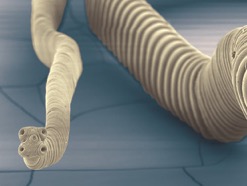2013
Hymenolepis Genome Published in Nature!
17/03/13 14:57


The first tapeworm genomes published in Nature! READ NOW
Editor’s summary:
Four tapeworm genomes sequenced
Tapeworms cause echinococcosis and cysticercosis, two of the most severe parasitic diseases found in humans, and both on the World Health Organization's list of neglected tropical diseases. The publication of four tapeworm genome sequences — human-infective tapeworm species Echinococcus multilocularis, E. granulosus, Taenia solium and the laboratory model Hymenolepis microstoma — and identification of potential new drug targets for treating tapeworm infections is therefore a welcome development. Analysis of the sequences provides insights into the evolution of parasitism and reveals extreme losses of genes and pathways ubiquitous in other animals on one hand and species-specific expansions of genes on the other. More than a thousand E. multilocularis proteins emerge as potential targets, and of these, close to 200 with the highest scores may be targeted with existing pharmaceuticals.
See videos and other PRESS coverage
Now Accepting Submissions: "Planarians to Parasitism" Special BMC Thematic Volume
21/01/13 14:33
Planarians to Parasitism: Evolution, Development and Stem Cells in Flatworms


We are pleased to announce that a new thematic series ‘Planarians to Parasitism: Evolution, Development and Stem Cells in Flatworms’ to be published jointly in EvoDevo and Parasites & Vectors is now accepting submissions. Pete Olson (Natural History Museum, London) will be guest Editor for this series, which aims to promote comparative approaches between the free-living and parasitic flatworm groups.
Historically, there has been a gap between the research conducted on parasitic and free-living flatworms due to the separate communities that work on them. This series aims to bridge this gap, bringing together diverse aspects of flatworm research for publication in one place. Recent availability of whole genome data and the ability to develop ‘new model’ organisms quickly, has provided a common language by which the groups may be more readily compared despite the great differences in their life histories and ecologies. More specifically, the themed series aims to emphasise three key topics in contemporary flatworm research: the ‘neoblast’ stem cell system, developmental and signalling pathways, and genome evolution. Wherever possible, authors are encouraged to provide insight into these and related topics using a comparative approach.
As open access journals, all articles published in the series will benefit from high visibility and permanent, free availability. Both journals can support unlimited figures and video clips and we would encourage authors to include as many of these as necessary.
Manuscripts can be submitted online via either journal homepage, clearly stating in your covering letter that your submission is intended for the ‘Planarians to Parasitism: Evolution, Development and Stem Cells in Flatworms’ thematic series.
For more information about the series or to discuss your potential contribution, please contact Pete Olson directly ([email protected]).
SEE THE BMC WEBSITE


We are pleased to announce that a new thematic series ‘Planarians to Parasitism: Evolution, Development and Stem Cells in Flatworms’ to be published jointly in EvoDevo and Parasites & Vectors is now accepting submissions. Pete Olson (Natural History Museum, London) will be guest Editor for this series, which aims to promote comparative approaches between the free-living and parasitic flatworm groups.
Historically, there has been a gap between the research conducted on parasitic and free-living flatworms due to the separate communities that work on them. This series aims to bridge this gap, bringing together diverse aspects of flatworm research for publication in one place. Recent availability of whole genome data and the ability to develop ‘new model’ organisms quickly, has provided a common language by which the groups may be more readily compared despite the great differences in their life histories and ecologies. More specifically, the themed series aims to emphasise three key topics in contemporary flatworm research: the ‘neoblast’ stem cell system, developmental and signalling pathways, and genome evolution. Wherever possible, authors are encouraged to provide insight into these and related topics using a comparative approach.
As open access journals, all articles published in the series will benefit from high visibility and permanent, free availability. Both journals can support unlimited figures and video clips and we would encourage authors to include as many of these as necessary.
Manuscripts can be submitted online via either journal homepage, clearly stating in your covering letter that your submission is intended for the ‘Planarians to Parasitism: Evolution, Development and Stem Cells in Flatworms’ thematic series.
For more information about the series or to discuss your potential contribution, please contact Pete Olson directly ([email protected]).
SEE THE BMC WEBSITE